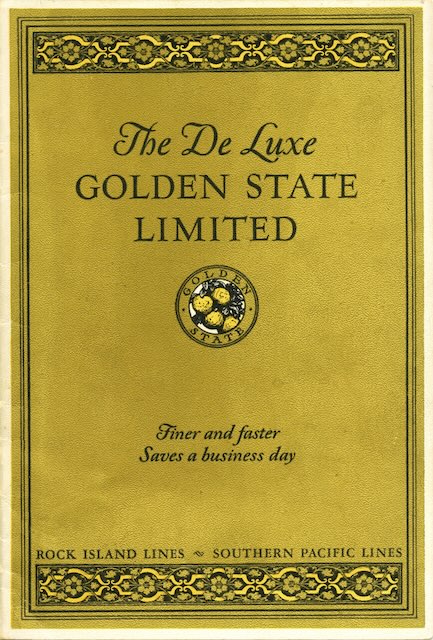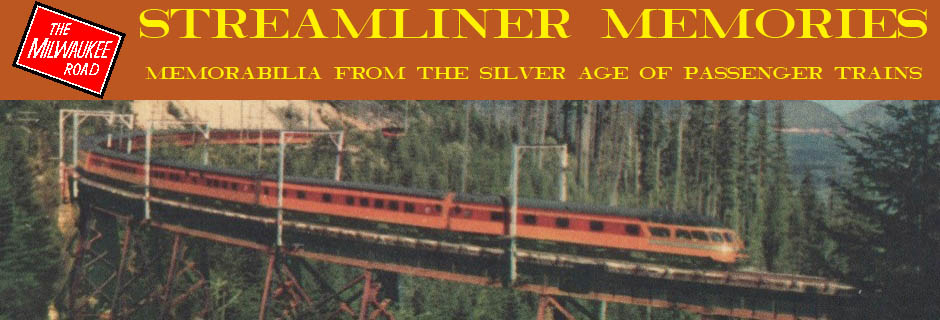As previously mentioned here, in 1926 the Santa Fe introduced the Chief, which went between Chicago and Los Angeles in 63 hours, five hours faster than previous trains. The railroad also charged a $10 extra fare (about $175 in today’s money). Union Pacific and Rock Island-Southern Pacific immediately sped up their premiere Chicago-LA trains and started charging a similar extra fare.
 Click image to download a 4.4-MB PDF of this 20-page booklet.
Click image to download a 4.4-MB PDF of this 20-page booklet.
Competing with trains that took the same amount of time and charged the same fare, this booklet attempts to distinguish the Golden State Limited as the train that offered “miles of comfort instead of miles of transportation.” For example, the observation car had a writing desk equipped with “paper, pens, ink, envelopes, telephone, the latest magazines and newspapers,” all helping to make “a trainload of comfort and convenience.”
The observation car included three compartments and two drawing rooms, a women’s lounge and shower bath, and of course an observation lounge with 15 chairs plus the above-mentioned writing desk. At the other end of the train was a club car with a large smoking room, a barber shop, buffet, and soda fountain. In-between was a 36-seat diner and sleeping cars.
Of course, the Chief and Los Angeles Limited had all of these amenities as well. The one thing that truly distinguished the Golden State as the “comfortable way” was that “there are no high altitudes on the Golden State route to affect or distress the respiration,” which was “an important consideration for those who are sensitive to high elevations, particularly elderly folks.”
The train typically carried at least four sleeping cars between Chicago and Los Angeles, two of which continued on to Santa Barbara or San Diego. At Kansas City, the westbound train picked up two more sleeping cars, one from St. Louis and one from Minneapolis. For some reason, the eastbound Minneapolis car returned on a different train.
The booklet has illustrations showing posh passengers served by attentive staff in all of these cars, plus one that appears to be a combined golf course and polo grounds. Diagrams of all the cars used on the Golden State Limited are in the back of this booklet.
The cover of the booklet is printed in a faux gold ink to emphasize the deluxe nature of the train. Inside, most of the pages are printed in orange, perhaps a reminder of the orange groves people would see if they took the train to southern California.
The last page lists travel bureaus and tiny print at the bottom indicates that 50,000 copies of this booklet were printed by Poole Brothers in Chicago in October 1927. At least three of the interior illustrations are signed “Klett,” which probably means Walter Charles Klett (1897-1966).
Born in St. Louis, Klett studied at the St. Louis School of Fine Arts and started a career in commercial art in Chicago in 1925 before moving to New York City in 1928. He did commercial artwork for many clients through the 1950s and was particularly known for painting “glamorous women.” That certainly fits this booklet, whose illustrations featuring at least 20 well-to-do women had been drawn during the years Klett lived in Chicago.

Pretty interesting that it appears cocktails had been served in the club car, and I may have spotted a beer bottle too. This was 1927 after all, and Prohibition was the law of the land.
Years ago, I read a book called Last Call which was about the Prohibition era. It was not nearly as difficult to get a drink if you really wanted one, and I am sure the well heeled passengers aboard the elite trains of that time had figured out all the work-arounds.
I don’t have any Rock Island or Southern Pacific menus from the Prohibition era, but a Union Pacific menu from 1928 lists sarsaparilla, root beer, apple cider, grape juice, loganberry juice, Coca Cola, and Red Raven, any of which could be in the bottles and beverage glasses in the image on page 11 of this booklet. While the railroad would not dispense alcohol, it would probably look the other way if passengers brought bottles carefully shielded in paper bags that were used to mix with beverages sold in the lounge car. Indeed, I have seen this happen aboard the Southern Crescent when it passed through dry states or counties in the 1970s.